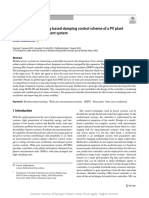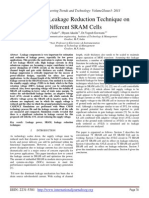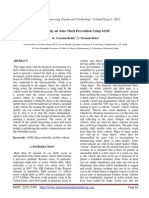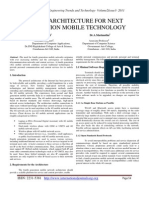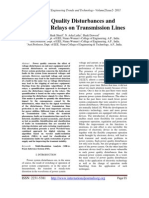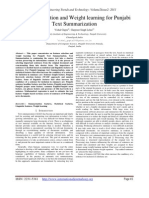Model-Based Programming of Intelligent Embedded Systems Through Offline Compilation
Model-Based Programming of Intelligent Embedded Systems Through Offline Compilation
Uploaded by
surendiran123Copyright:
Available Formats
Model-Based Programming of Intelligent Embedded Systems Through Offline Compilation
Model-Based Programming of Intelligent Embedded Systems Through Offline Compilation
Uploaded by
surendiran123Original Title
Copyright
Available Formats
Share this document
Did you find this document useful?
Is this content inappropriate?
Copyright:
Available Formats
Model-Based Programming of Intelligent Embedded Systems Through Offline Compilation
Model-Based Programming of Intelligent Embedded Systems Through Offline Compilation
Uploaded by
surendiran123Copyright:
Available Formats
International Journal of Engineering Trends and Technology- Volume2Issue2- 2011
Model-Based Programming of Intelligent Embedded Systems Through Offline Compilation
K. Sundar Srinivas1, K. Naga Lakshmi Kalyani2
2
M.Tech, Dept. of ECE, Nova College of Engineering & Technology, A.P., India. Asst.Professor, Dept. of ECE, Potti Sriramulu College of Engineering & Technology, A.P., India. interact other than expected, and a rule-based system cannot account for this. Should such a fault occur at a critical mission point, such as orbital insertion, the rule-based engine cannot react, resulting in the loss of the mission? Embedded systems, from automobiles to officebuilding control systems, are achieving unprecedented levels of robustness by dramatically increasing their use of computation. We envision a future with large networks of highly robust and increasingly autonomous embedded systems. These visions include intelligent highways that reduce congestion, cooperative networks of air vehicles for search and rescue, and fleets of intelligent space probes that autonomously explore the far reaches of the solar system. Many of these systems will need to perform robustly within extremely harsh and uncertain environments, or may need to operate for years with minimal attention. To accomplish this, these embedded systems will need to radically reconfigure themselves in response to failures, and then accommodate these failures during their remaining operational lifetime. We support the rapid development of these systems by creating embedded programming languages that are able to reason about and control underlying hardware from engineering models. We call this approach model-based programming.
Abstract - Many recent and future space missions point to the need for increased autonomy in spacecraft with an emphasis on more capable fault diagnostic systems. The most widely used fault diagnostic systems are rule-based. Rule-based systems have quick response to events and clearly present to engineers the predefined reactions to events. These systems, however, require engineers to manually generate all necessary rules and these do not convey the assumed model the engineers used to generate the rules. Contrarily, model-based systems eliminate the need to manually generate the rules. Programming complex embedded systems involves reasoning through intricate system interactions along lengthy paths between sensors, actuators, and control processors. This is a challenging, time-consuming, and error-prone process requiring significant interaction between engineers and software programmers. Furthermore, the resulting code generally lacks modularity and robustness in the presence of failure. Model-based programming addresses these limitations, allowing engineers to program reactive systems by specifying high-level control strategies and by assembling commonsense models of the system hardware and software. KeywordsConstraint programming, model-based autonomy, model-based execution, model-based programming.
I. INTRODUCTION Recent failures in NASAs Mars exploration program point to the need for increased autonomy in spacecraft. Spacecraft must be designed with the capacity to monitor their own systems for unexpected occurrences, and to react in a timely fashion to such conditions at the executive layer, i.e. at the level of real-time commanding. The ability to accurately and rapidly determine the current state of the system is vital to the design of fault protection systems in autonomous spacecraft. Many fault management systems are based on expert systems in which a rulebased diagnostic engine is used to detect faults. For example, the NEAR spacecraft used such a system for limited autonomous operations. This type of systems capability is limited to the rules enumerated in the database. To create these rules, engineers must reason through system wide interactions, consequently, the set of rules is limited by the faults that engineers can recognize. This lack of robustness can be detrimental to the spacecraft. Components may
A. Robustness in Deep Space
In the past, high levels of robustness under extreme uncertainty were largely the realm of deep-space exploration. Billion-dollar space systems, like the Galileo Jupiter probe, have achieved robustness by employing sizable software development teams and by using many operations personnel to handle unforeseen circumstances as they arise. Efforts to make these missions highly capable at dramatically reduced costs have proven extremely challenging, producing notable losses, such as the Mars Polar Lander and Mars Climate Orbiter failures [1]. A contributor to these failures was the inability of the small software team to think through the large space of potential interactions between the embedded software and its underlying hardware.
ISSN: 2231-5381
http://www.internationaljournalssrg.org
Page 24
International Journal of Engineering Trends and Technology- Volume2Issue2- 2011
For example, consider the leading hypothesis for the cause of the Mars Polar Lander failure. Mars Polar Lander used a set of Hall Effect sensors in its legs to detect touchdown. These sensors were watched by a set of software monitors, which were designed to turn off the engine when triggered. As the lander descended into the Mars atmosphere, it deployed its legs. At this point it is most likely that the force of deployment produced a noise spike on the leg sensors, which was latched by the software monitors. The lander continued to descend, using a laser altimeter to detect distance to the surface. At an altitude of approximately 40 m, the lander began polling its leg monitors to determine touchdown. It would have immediately read the latched noise spike and shut down its engine prematurely, resulting in the spacecraft plummeting to the surface from 40 m [2]. B. A MODEL-B ASED PROGRAMMING EXAMPLE Model-based programming enables a programmer to focus on specifying the desired state evolutions of the system. For example, consider the task of inserting a spacecraft into orbit around a planet. Our spacecraft includes a science camera and two identical redundant engines (Engines A and B), as shown in Fig. 3. An engineer thinks about this maneuver in terms of state trajectories: Heat up both engines (called standby mode). Meanwhile, turn the camera off, in order to avoid plume contamination novel failures as they arise. This is essential for achieving high levels of robustness. 2. MINI-ME Mini-ME differs from previous model-based fault monitoring systems by guaranteeing run time performance. Through model compilation and offline deduction, Mini-ME combines the benefits of the rule based systems real time performance guarantees and the model-based fault protection systems capability to reason on models. 2.1 Example System The diagnostic ability of Mini-ME will be demonstrated in the following sections using a simplified schematic of a monopropellant propulsion system used for attitude control in the NEAR spacecraft, shown in Figure 2.
Figure 2: Monopropellant Propulsion System Schematic The propulsion system comprises two overall subsystems, the tank of hydrazine and its associated pressure transducer, and the hydrazine thruster made up of the solenoid valve, catalyst bed and physical thruster. An inertial sensor is included in the system for thrust observation. The hydrazine thruster is made up of two main components, the solenoid valve and the catalyst bed. The solenoid valve controls the hydrazine flow into the catalyst bed. This is accomplished by applying an electric current to the valve to open it, otherwise it will remain closed. Downstream of the solenoid valve is the catalyst bed, which is needed for combustion. Over time, catalyst can be lost through various mechanisms, such as pieces breaking off due to temperature variations. This will cause a reduction in thrust from the hydrazine thruster, causing the inertial sensor to observe that the thrust is off. In the case
Fig. 3 Simple spacecraft for the orbital insertion scenario. Initial state (left) and goal state (right) are depicted. When both are accomplished, thrust one of the two engines, using the other engine as backup in case of primary engine failure. This specification is far simpler than a control program that must turn on heaters and valve drivers, open valves and interpret sensor readings for the engines shown in the figure. Thinking in terms of more abstract hidden states makes the task of writing the control program much easier and avoids the error-prone process of reasoning through low-level system interactions. In addition, it gives the programs execution kernel the latitude to respond to
ISSN: 2231-5381
http://www.internationaljournalssrg.org
Page 25
International Journal of Engineering Trends and Technology- Volume2Issue2- 2011
that the ACS operates nominally, the inertial sensors reading will be discretized as on. We start by specifying the two components of a model based program for orbital insertion: the control program and plant model. We then describe the execution of the program under nominal and failure situations. A. Control Program The RMPL control program, shown in Fig. 4, encodes the informal specification we gave previously as a set of state trajectories. The specific RMPL constructs used in the program are introduced in Section IV. Recall that to perform orbital insertion, one of the two engines must be fired. We start by concurrently placing the two engines in the standby state and by shutting off the camera. This is performed by lines 35, where commas at the end of each line denote parallel composition. We then fire an engine, choosing to use Engine A as the primary engine (lines 69) and Engine B as a backup, in the event that Engine A fails to fire correctly (lines 1011). Engine A starts trying to fire as soon as it achieves standby and the camera is off (line 7), but aborts if at any time Engine A is found to be in a failure state (line 9). Engine B starts trying to fire only if Engine A has failed, B is in standby, and the camera is off (line 10). Several features of this control program reinforce our earlier points. First, the program is stated in terms of state assignments to the engines and camera, such as EngineB = Firing. Second, these state assignments appear both as assertions and as execution conditions. For example, in lines 69, EngineA = Firing appears in an assertion (line 8), while EngineA = Standby, Camera = Off, and EngineA = Failed appear in execution conditions (lines 7 and 9). Third, none of these state assignments are directly observable or controllable, only shutter position and acceleration may be directly sensed, and only the flight computer command may be directly set. Finally, by referring to hidden states directly, the RMPL program is far simpler than a corresponding program that operates on sensed and controlled variables. The added complexity of the latter program is due to the need to fuse sensor information and generate command sequences under a large space of possible operation and fault scenarios. B. Plant Model The plant model is used by a model-based executive to map queried and asserted states in the control program to sensed variables and control sequences, respectively, in the physical plant. The plant model is built from a set of component models. Each component is represented by a set of component modes, a set of constraints defining the behavior within each mode, and a set of probabilistic transitions between modes. The component automata operate concurrently and synchronously. 1 OrbitInsert()::{ 2 do { 3 EngineA=Standby, 4 EngineB=Standby, 5 Camera=Off, 6 do { 7 when EngineA=Standby ^ Camera=Off 8 donext EngineA=Firing 9 } watching EngineA=Failed, 10 when EngineA=Failed ^ EngineB=Standby ^ Camera=Off 11 donext EngineB=Firing 12 } watching EngineA=Firing v EngineB=Firing 13 } Fig. 4 RMPL control program for the orbital insertion scenario. III. RULE SYSTEM ANALYSIS A comparison to a real system is the best validation for the Mini-ME fault diagnosis tool. For verification, a NEAR-like power system and its associated rules were analyzed to develop appropriate Mini-ME models to obtain diagnoses of particular faults. These rules have several characteristics relating to Mini-ME, the first being the dependency on time. In all of the rules, the observation must be made for a certain length of time before it is triggered. This dependency is moved outside of Mini-ME through the use of the monitors. Monitors can be designed with a counter that is incremented when an observation falls in a certain range, such as if the charger current exceeds 0.8 A. Only when the counter reaches a certain value, corresponding to 10 seconds for rule 3, then would the monitor send the observation that the charger current is high. This use of discretization allows the modeling to be more intuitive and understandable as the model is now specified in a more qualitative way.
Table 2. NEAR-like Power Storage System Rules
ISSN: 2231-5381
http://www.internationaljournalssrg.org
Page 26
International Journal of Engineering Trends and Technology- Volume2Issue2- 2011
No. 1 2 3 Symptom (Battery Current > 0.6A) For 60 sec (Redundant battery charger is ON) for 5 sec (Charger current > 0.8 A) for 10 sec (Charger current > 0.07A) and (Bus Voltage > 24 V) for 10 sec (Battery Temp > 30 C) for 1 hour Recovery Action Turn off the charger stop rules 2 and 3 Switch to the redundant charger, and disengage the primary. Same recovery as rule 2. models and observations from the system, Mini-ME generates a diagnosis of the systems components using a best first search to generate the most likely diagnosis. This diagnosis gives the state of the system, which is not available in a rule-based system. In rule-based systems, the mapping from symptoms to recovery action is apparent, but not the mapping from symptoms to the system state. Making this step explicit leads to rules that are easier to analyze for completeness, and a rule set smaller in size. In the case of the example system in section 2, it requires only 6 dissents to represent the faults, whereas a rule-based system would require 32 rules to represent all of the possible faults. These characteristics lead to more reliable fault protection as it makes the process of rule generation modular by using models of the system, monitors that discretized observations and repair actions based on the diagnoses, all of which are designed by the engineer in a clear manner. A key benefit of the MiniME system and the use of associated repair manager, aside from the model-based approach, is that they give the spacecraft the ability to remain operational in the face of component failures. This ability is crucial as space exploration expands. The same individuals who designed the spacecraft may not be around when it lands, which necessitates fault diagnosis ability. Acknowledgment I am thankful to my Guide Miss. K. Naga Lakshmi Kalyani Asst.Professor Dept.of ECE for her valuable suggestion to complete my thesis paper in intime. REFERENCES
[1] T. Young et al.. (2000) Report of the Mars Program Independent Assessment Team. NASA, Washington, DC. [Online] Available: http://www.nasa.gov/newsinfo/marsreports.html [2] J. Casani et al., Report on the Loss of the Mars Polar Lander and Deep Space 2 Missions, NASA Jet Propulsion Laboratory, Pasadena, CA, JPL D-18 709, 2000. [3] B. Williams and P. Nayak. 1997. A Reactive Planner for a Model-based Executive. In Proceedings of the International Joint Conference on Artificial Intelligence (IJCAI-97). [4] B. Williams, S. Chung, and V. Gupta. Mode Estimation of Model-based Programs: Monitoring Systems with Complex Behavior, To appear in Proceedings of the International Joint Conference on Artificial Intelligence, Seattle,WA.2001.around when it lands, which necessitates fault diagnosis ability.
Switch to the redundant charger and turn its trickle charge on
A second characteristic of a NEAR-like rule is that different symptoms can lead to the same recovery action, such as the conditions for switching to the redundant charger (rules 3 and 4). These types of rule combinations may have the same resulting action, but lead to a different state for the component. Hidden in these rules then is the state of the power system that the engineer had to determine. For instance, in the case of rule 3, this would mean that the charger has become broken in some way, thus identifying the state, and the model of this mode would come from these symptoms. Mini-ME has also been used as a tool to understand model compilation techniques and its applications. Other such applications that use this technique include a mode estimation capability for the Reactive Model based Programming Language (RMPL) [3], and a reactive planning system, Burton [4]. IV. CONCLUSION Fault protection in spacecraft is a must as missions venture further into space and space systems increase in complexity. The necessity of a system that can perform this fault diagnosis in real time is then a key component. The Mini-ME fault protection system has been shown to meet this goal without any loss of information from a rule-based system. The utilization of system models in Mini-ME allows it to perform diagnosis of components. A model-based approach has many benefits including reusability, compositionality and specification of intuitive models. The use of these models to perform reasoning and deduction has been shifted to an offline operation, an approach that differs from previous systems such as Sherlock and Livingstone. This offline compilation of the models to rules, called dissents, allows Mini-ME to perform fast diagnosis of faults online. Using these
ISSN: 2231-5381
http://www.internationaljournalssrg.org
Page 27
You might also like
- Onboard and Ground Station Telemetry Architecture Design For A LEO NanosatelliteDocument18 pagesOnboard and Ground Station Telemetry Architecture Design For A LEO NanosatelliteEBEN EZERNo ratings yet
- Vertical Rotor For The Implementation of Control LawsDocument6 pagesVertical Rotor For The Implementation of Control LawsLuis Fernando Callejas MarinNo ratings yet
- SKYLON User Manual Rev1Document52 pagesSKYLON User Manual Rev1Jarek JaworskiNo ratings yet
- A Synopsis ONDocument11 pagesA Synopsis ONRAJAT NEGINo ratings yet
- Electronics 07 00256Document26 pagesElectronics 07 00256tou kaiNo ratings yet
- Sliding Mode Control TechniquesDocument6 pagesSliding Mode Control TechniquesSyed Zain BukhariNo ratings yet
- Autonomous Flight in Unstructured and Unknown Indoor EnvironmentsDocument8 pagesAutonomous Flight in Unstructured and Unknown Indoor EnvironmentsJames KnotNo ratings yet
- Get PDF 3Document4 pagesGet PDF 3Kavin Kumar JNo ratings yet
- Jun 1999 277 PDFDocument8 pagesJun 1999 277 PDFbbscribedNo ratings yet
- Direct and Indirect Dual Axis Solar Tracking System With Weather ConditionDocument63 pagesDirect and Indirect Dual Axis Solar Tracking System With Weather ConditionRukminiNo ratings yet
- 1272-Document Upload-6080-1-10-20201103Document14 pages1272-Document Upload-6080-1-10-20201103呂文祺No ratings yet
- ChaptersDocument44 pagesChaptersMaria KhanNo ratings yet
- Unmanned Aerial Vehicles - Robotic Air Warfare 1917-2007Document94 pagesUnmanned Aerial Vehicles - Robotic Air Warfare 1917-2007mohanNo ratings yet
- Artificial Intelligence Research in Particle Accelerator Control Systems For Beam Line TuningDocument3 pagesArtificial Intelligence Research in Particle Accelerator Control Systems For Beam Line TuningAmna MajidNo ratings yet
- Blimp Stabilization Controller OptimizatDocument8 pagesBlimp Stabilization Controller Optimizatstarvz95No ratings yet
- Visakh SeminarDocument20 pagesVisakh SeminariagooNo ratings yet
- Frictionless Spacecraft Simulator With Unrestricted Three Axis Movement For NanosatsDocument12 pagesFrictionless Spacecraft Simulator With Unrestricted Three Axis Movement For NanosatsMaman de AnisNo ratings yet
- Electronics: Design and Implementation of Attitude Stabilization System For Marine Satellite Tracking AntennaDocument19 pagesElectronics: Design and Implementation of Attitude Stabilization System For Marine Satellite Tracking AntennaDouglas LimaNo ratings yet
- Metode Monitoring Trafo DistributionDocument5 pagesMetode Monitoring Trafo DistributionSiswoyo SuwidjiNo ratings yet
- System Identification MechatronicDocument5 pagesSystem Identification MechatronicBruno DuchiniNo ratings yet
- Model-Based Avionic Prognostic Reasoner (MAPR) PDFDocument9 pagesModel-Based Avionic Prognostic Reasoner (MAPR) PDFlalith.shankar7971No ratings yet
- The Meaning of Requirements: 101 Hamilton Terrace, London NW8 9QX, EnglandDocument17 pagesThe Meaning of Requirements: 101 Hamilton Terrace, London NW8 9QX, EnglandJyothsna Priya KattakindaNo ratings yet
- Stereo Vision and Laser Odometry For Autonomous Helicopters in GPS-denied Indoor EnvironmentsDocument11 pagesStereo Vision and Laser Odometry For Autonomous Helicopters in GPS-denied Indoor Environmentsp_p9No ratings yet
- Controller Design ThesisDocument4 pagesController Design Thesisaprilgriffinbeaumont100% (2)
- CCE 2018 Paper 119Document5 pagesCCE 2018 Paper 119JLuis LuNaNo ratings yet
- Distributed and Cooperative Satellites Simulation ToolDocument7 pagesDistributed and Cooperative Satellites Simulation ToolMiguel Adrian CarreteroNo ratings yet
- FSR05 Sky SailorDocument12 pagesFSR05 Sky SailorAndrei BadulescuNo ratings yet
- Dual Axis Solar TrackerDocument12 pagesDual Axis Solar Trackertsuu0213No ratings yet
- 2022 Sensor Fault-Tolerant Control of A Quadrotor Unmanned Aerial Vehicle 417-433Document17 pages2022 Sensor Fault-Tolerant Control of A Quadrotor Unmanned Aerial Vehicle 417-433Umut BaşkanNo ratings yet
- Low-Cost Dual-Axis System For Solar Tracking: Dimitrija Angelkov Natasa Koceska Saso KoceskiDocument4 pagesLow-Cost Dual-Axis System For Solar Tracking: Dimitrija Angelkov Natasa Koceska Saso KoceskiRegard AlestairNo ratings yet
- Control Methods For QuadsDocument28 pagesControl Methods For Quadshw606No ratings yet
- An Itae Optimal Sliding Mode Controller For Systems With Control Signal and Velocity LimitationsDocument9 pagesAn Itae Optimal Sliding Mode Controller For Systems With Control Signal and Velocity LimitationsMIKS DARKNo ratings yet
- RF Seeker Stabilisation AntenneDocument4 pagesRF Seeker Stabilisation AntennetttNo ratings yet
- Supervisory SystemsDocument23 pagesSupervisory Systemspotugaadu1No ratings yet
- Evaluation of Progressive Deterioration of A Squirrel-Cage Rotor, With A Condition Monitoring System That Implements The Sideband MethodologyDocument6 pagesEvaluation of Progressive Deterioration of A Squirrel-Cage Rotor, With A Condition Monitoring System That Implements The Sideband MethodologyLeo ArguijoNo ratings yet
- Reinforcement-Learning-Based Damping Control SchemDocument14 pagesReinforcement-Learning-Based Damping Control SchemjamesNo ratings yet
- Feedback Linearization and High Order Sliding Mode Observer For A Quadrotor UAVDocument8 pagesFeedback Linearization and High Order Sliding Mode Observer For A Quadrotor UAVVictor Hugo OrtizNo ratings yet
- Bad Data Detection in Smart GridDocument24 pagesBad Data Detection in Smart GridsbaaliaNo ratings yet
- Software Test Techniques For System Fault-Tree AnalysisDocument13 pagesSoftware Test Techniques For System Fault-Tree AnalysisShakil HussainNo ratings yet
- Detecting Abnormal Machine Characteristics in Cloud InfrastructuresDocument8 pagesDetecting Abnormal Machine Characteristics in Cloud InfrastructuresMahammad SheekaNo ratings yet
- Estimation and Control Under Information Constraints For LAAS Helicopter BenchmarkDocument8 pagesEstimation and Control Under Information Constraints For LAAS Helicopter BenchmarkAbdallah Omar Al AyoubiNo ratings yet
- Design of A Solar Array Peak Power Tracking System: NASA1 Engineering, IncDocument27 pagesDesign of A Solar Array Peak Power Tracking System: NASA1 Engineering, IncalagurmNo ratings yet
- Full Report ControlDocument13 pagesFull Report Controlariff aliNo ratings yet
- Aerial Surviellance of LineDocument8 pagesAerial Surviellance of Linelalit123indiaNo ratings yet
- Literature Review On Automatic Sun Tracking SystemDocument4 pagesLiterature Review On Automatic Sun Tracking SystemafmabbpoksbfdpNo ratings yet
- Small Signal Stability of A Large Power System As Affected by New Generation Additions by Prabha KundurDocument5 pagesSmall Signal Stability of A Large Power System As Affected by New Generation Additions by Prabha KundurAuspiciousNo ratings yet
- Design of Fault Tolerant System For The On-Board Computer of Studsat-2Document1 pageDesign of Fault Tolerant System For The On-Board Computer of Studsat-2ShrinivasPaiNo ratings yet
- Low-Cost Accelerometers For Robotic Manipulator PerceptionDocument7 pagesLow-Cost Accelerometers For Robotic Manipulator PerceptionAbbé BusoniNo ratings yet
- Enhanced Antenna Positioning Control System Using Adapted DC Servo Motor and Fuzzy-PI ControllerDocument8 pagesEnhanced Antenna Positioning Control System Using Adapted DC Servo Motor and Fuzzy-PI ControllerRifqi Yazid AdnanNo ratings yet
- Turbomachinery CFD On Parallel ComputersDocument20 pagesTurbomachinery CFD On Parallel ComputersYoseth Jose Vasquez ParraNo ratings yet
- Research Article: Design and Manufacturing of A High-Precision Sun Tracking System Based On Image ProcessingDocument8 pagesResearch Article: Design and Manufacturing of A High-Precision Sun Tracking System Based On Image ProcessingTopea AlexandruNo ratings yet
- Architecture of A Fault Diagnosis Expert System For Power Plants ProtectionDocument5 pagesArchitecture of A Fault Diagnosis Expert System For Power Plants Protectionserg6007No ratings yet
- UoN RobotX 2014Document21 pagesUoN RobotX 2014Ismail.m.elgadi ElgadiNo ratings yet
- Applications of Calculation Channel Function in Hybrid SimulationDocument11 pagesApplications of Calculation Channel Function in Hybrid SimulationAlbaProyectoNo ratings yet
- NejmSaadallah Aditional PaperDocument14 pagesNejmSaadallah Aditional PaperDhrubajyoti BoraNo ratings yet
- Solevrcs. Smart OlevDocument11 pagesSolevrcs. Smart Olevrrg_abraxNo ratings yet
- Cubesat Deformable Mirror Demonstration: CitationDocument12 pagesCubesat Deformable Mirror Demonstration: CitationjonNo ratings yet
- Fault Detection and Isolation in Robotic Manipulator Via Hybrid Neural NetworksDocument12 pagesFault Detection and Isolation in Robotic Manipulator Via Hybrid Neural Networksnick4nameNo ratings yet
- Fault Detection and Diagnosis For Sensor in An Aero-Engine SystemDocument6 pagesFault Detection and Diagnosis For Sensor in An Aero-Engine Systemjymcrusher42No ratings yet
- 4 NatDocument11 pages4 NatManoj BadoniNo ratings yet
- Advances in Motion Sensing and Control for Robotic Applications: Selected Papers from the Symposium on Mechatronics, Robotics, and Control (SMRC’18)- CSME International Congress 2018, May 27-30, 2018 Toronto, CanadaFrom EverandAdvances in Motion Sensing and Control for Robotic Applications: Selected Papers from the Symposium on Mechatronics, Robotics, and Control (SMRC’18)- CSME International Congress 2018, May 27-30, 2018 Toronto, CanadaFarrokh Janabi-SharifiNo ratings yet
- Automated Anomaly and Root Cause Detection in Distributed SystemsDocument6 pagesAutomated Anomaly and Root Cause Detection in Distributed Systemssurendiran123No ratings yet
- A Class Based Approach For Medical Classification of Chest PainDocument5 pagesA Class Based Approach For Medical Classification of Chest Painsurendiran123No ratings yet
- Ijett V3i2p204Document3 pagesIjett V3i2p204surendiran123No ratings yet
- PCA Based Image Enhancement in Wavelet DomainDocument5 pagesPCA Based Image Enhancement in Wavelet Domainsurendiran123No ratings yet
- Geostatistical Analysis Research: International Journal of Engineering Trends and Technology-Volume2Issue3 - 2011Document8 pagesGeostatistical Analysis Research: International Journal of Engineering Trends and Technology-Volume2Issue3 - 2011surendiran123No ratings yet
- Analysis of Leakage Reduction Technique On Different SRAM CellsDocument6 pagesAnalysis of Leakage Reduction Technique On Different SRAM Cellssurendiran123No ratings yet
- Analysis of Dendrogram Tree For Identifying and Visualizing Trends in Multi-Attribute Transactional DataDocument5 pagesAnalysis of Dendrogram Tree For Identifying and Visualizing Trends in Multi-Attribute Transactional Datasurendiran123No ratings yet
- Double Encryption Based Secure Biometric Authentication SystemDocument7 pagesDouble Encryption Based Secure Biometric Authentication Systemsurendiran123No ratings yet
- A Study On Auto Theft Prevention Using GSMDocument5 pagesA Study On Auto Theft Prevention Using GSMsurendiran123No ratings yet
- Design Architecture For Next Generation Mobile TechnologyDocument6 pagesDesign Architecture For Next Generation Mobile Technologysurendiran123No ratings yet
- Dynamic Modeling and Control of A Wind-Fuel Cell Through Hybrid Energy SystemDocument5 pagesDynamic Modeling and Control of A Wind-Fuel Cell Through Hybrid Energy Systemsurendiran123No ratings yet
- Transformer Less DC - DC Converter With High Step Up Voltage Gain MethodDocument6 pagesTransformer Less DC - DC Converter With High Step Up Voltage Gain Methodsurendiran123No ratings yet
- RFID-Based Mobile Robot Positioning - Sensors and TechniquesDocument5 pagesRFID-Based Mobile Robot Positioning - Sensors and Techniquessurendiran123No ratings yet
- Model-Driven Performance For The Pattern and Advancement of Software Exhaustive SystemsDocument6 pagesModel-Driven Performance For The Pattern and Advancement of Software Exhaustive Systemssurendiran123No ratings yet
- Organizational Practices That Effects Software Quality in Software Engineering ProcessDocument6 pagesOrganizational Practices That Effects Software Quality in Software Engineering Processsurendiran123No ratings yet
- Adaptive Active Constellation Extension Algorithm For Peak-To-Average Ratio Reduction in OfdmDocument11 pagesAdaptive Active Constellation Extension Algorithm For Peak-To-Average Ratio Reduction in Ofdmsurendiran123No ratings yet
- Dynamic Search Algorithm Used in Unstructured Peer-to-Peer NetworksDocument5 pagesDynamic Search Algorithm Used in Unstructured Peer-to-Peer Networkssurendiran123No ratings yet
- An Efficient Passive Approach For Quality of Service Routing in ManetsDocument6 pagesAn Efficient Passive Approach For Quality of Service Routing in Manetssurendiran123No ratings yet
- Color Feature Extraction of Tomato Leaf DiseasesDocument3 pagesColor Feature Extraction of Tomato Leaf Diseasessurendiran123No ratings yet
- VSC Based DSTATCOM & Pulse-Width Modulation For Power Quality ImprovementDocument4 pagesVSC Based DSTATCOM & Pulse-Width Modulation For Power Quality Improvementsurendiran123No ratings yet
- Power Quality Disturbances and Protective Relays On Transmission LinesDocument6 pagesPower Quality Disturbances and Protective Relays On Transmission Linessurendiran123No ratings yet
- Features Selection and Weight Learning For Punjabi Text SummarizationDocument4 pagesFeatures Selection and Weight Learning For Punjabi Text Summarizationsurendiran123No ratings yet
- Extended Linearization Technique: GPS User Position UsingDocument4 pagesExtended Linearization Technique: GPS User Position Usingsurendiran123No ratings yet
- Experimental Investigation For Welding Aspects of AISI 304 & 316 by Taguchi Technique For The Process of TIG & MIG WeldingDocument6 pagesExperimental Investigation For Welding Aspects of AISI 304 & 316 by Taguchi Technique For The Process of TIG & MIG Weldingsurendiran123No ratings yet
- Satellite Design Course Spacecraft Configuration Structural Design Preliminary Design MethodsDocument85 pagesSatellite Design Course Spacecraft Configuration Structural Design Preliminary Design Methodsmegustalazorra100% (1)
- 30th March:: - Download FromDocument12 pages30th March:: - Download Frombabubhai23No ratings yet
- The Art of Systems Engineering Rev 1 - John MuratoreDocument36 pagesThe Art of Systems Engineering Rev 1 - John MuratorevertexrwpNo ratings yet
- AlienDocument133 pagesAlienAdriano Rosas100% (5)
- Choose Your Planet - Earth and Life SciencesDocument2 pagesChoose Your Planet - Earth and Life SciencesLouise Joseph G. Peralta100% (1)
- XFOILDocument2 pagesXFOILbwwatsonNo ratings yet
- ScanEagle Dual Bay Folder InsertDocument2 pagesScanEagle Dual Bay Folder Insertkishore13No ratings yet
- 22 01 13-22 01 31.sfosDocument20 pages22 01 13-22 01 31.sfosZay ApNo ratings yet
- Labs Activities List Ap Physics 1 Ib 2014Document2 pagesLabs Activities List Ap Physics 1 Ib 2014api-261404965No ratings yet
- Planetary Gear White PaperDocument3 pagesPlanetary Gear White PaperdressfeetNo ratings yet
- Aiaa 2009 530 230Document10 pagesAiaa 2009 530 230mycrowsobt1No ratings yet
- Gemini 5 PAO TranscriptDocument799 pagesGemini 5 PAO TranscriptBob AndrepontNo ratings yet
- Stars and Solar SystemDocument42 pagesStars and Solar SystemABINAV RAGHAV100% (1)
- Shuttle Manual GlobalDocument25 pagesShuttle Manual GlobalwinuxitaNo ratings yet
- OrbitsDocument2 pagesOrbitsPantsik GrifoiNo ratings yet
- Rotor Blade Head DesignDocument8 pagesRotor Blade Head DesignAmitanand Surlikerimath100% (1)
- Interesting FactsDocument11 pagesInteresting FactsmcdanielsamanthaNo ratings yet
- AE 440A Aerospace Vehicle Design: Aircraft: Course DescriptionDocument12 pagesAE 440A Aerospace Vehicle Design: Aircraft: Course DescriptionKelvin SudaniNo ratings yet
- Apollo 10 Final Flight PlanDocument278 pagesApollo 10 Final Flight PlanBob Andrepont100% (2)
- 23 Steep SpiralDocument8 pages23 Steep SpiralashNo ratings yet
- (C) The Nautical AlmanacDocument17 pages(C) The Nautical AlmanacBernard Mamora100% (2)
- Together kl5 U6 Unit Test ChallengeDocument2 pagesTogether kl5 U6 Unit Test ChallengeRufi StreamNo ratings yet
- M.E Aerospace Technology FULL TIME MODE (4 Semester) Semester I (Common To Launch Vehicle Technology (LVT) & Satellite Technology (ST) )Document5 pagesM.E Aerospace Technology FULL TIME MODE (4 Semester) Semester I (Common To Launch Vehicle Technology (LVT) & Satellite Technology (ST) )AerospaceBishal Mozart GhimireyNo ratings yet
- EVS Model Question Paper-1 I. Choose The Best Answer 5x1 5Document6 pagesEVS Model Question Paper-1 I. Choose The Best Answer 5x1 5Bala MuruganNo ratings yet
- User ManualDocument7 pagesUser ManualherbakNo ratings yet
- Maghrabi 2016Document6 pagesMaghrabi 2016AlexandraNo ratings yet
- Development of The Apollo Launch Escape SystemDocument6 pagesDevelopment of The Apollo Launch Escape SystemKanishka LankatillakeNo ratings yet
- Strategi PKPPKDocument138 pagesStrategi PKPPKaan_pkppkNo ratings yet
- Day Since 11052019 - Google SearchDocument1 pageDay Since 11052019 - Google Searchnbkzxqqtf4No ratings yet



































